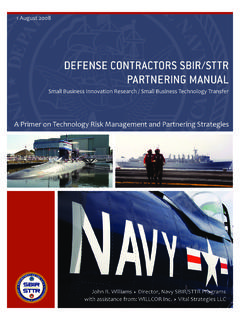Transcription of Creating Effective Strategic Partnerships - EXCELLENC
1 Page 1 of 3 Dimensions of EXCELLENCE is based on the four dimensions of performance and organizational excellence. These are the foundation for our development programs oriented to achieving performance and organizational excellence in sales, marketing, and customer service. These white papers provide concepts and ideas based on the application of these principles of these programs and our work with our clients. We welcome your comments and observations on these topics. For more information on our products and services, contact: Partners In EXCELLENCE 22715 Barlovento Mission Viejo, CA 92692 PH: 949-305-7146 FAX: 949-305-7164 Email: 1997-2003 Partners In EXCELLENCE, All Rights Reserved.
2 Everyone talks about them. Executives speak of Partnerships and alliances as being core to their strategies. Salespeople want to partner with their customers. Developers seek alliances to acquire technology, knowledge, and capabilities. Marketers seek Partnerships to open new markets and segments. The merger-mania that is sweeping business is a form of partnering . Other forms of Partnerships are joint ventures, technology alliances, supplier-chain alliances, outsourcing, and virtual companies. Countless consulting companies offer seminars on partnering . Strategic partnering is one of the buzzword bingo favorites. Sales people and marketers often use Partnerships as an advanced form of selling, doing no more than using the offer of a partnership as just another way of closing the customer on the latest deal.
3 Partnerships in this context end up being I want you to do something for me, not how can we work together for mutual benefit. partnering seems to be the automatic answer to expanding sales, markets and growing a company. Yet the majority of Partnerships and alliances fail to achieve their objectives. Some data indicates that the failure rate of Partnerships is as high as 70%.1 Others, while not declared failures, end up being paper Partnerships and not real collaborations that produce meaningful results. Strategic alliances are critical elements to many business strategies. No organization can do everything, so alliances become powerful means of enriching the solutions and value we provide our customers, improving our access to new markets and customers, and growing our own knowledge, capabilities, and companies.
4 We can extend our core competencies through entering into relationships with organizations that have capabilities that complement ours. Creating relationships that produce meaningful results, for each party, requires hard work and commitment. Based on our experience, Effective Partnerships can be expressed in the following manner: Maximizing (SR)3 +( SV)2 = High Effectiveness Stated differently, Effective Partnerships are a combination of the following factors: Shared Risk: Each partner bears a fair and appropriate share of the risk in the alliance. No partner has a disproportionate level of risk. Shared Resources: Each partner commits an appropriate proportion of the resources, whether they are capital, people, knowledge, technology or other.
5 Shared Rewards: Each partner shares appropriately in the rewards, the partners work together to create mutual wins. Shared Vision: The partners share a common view of the objectives, results and outcomes of the alliance. They share a common vision of the importance of the relationship. Shared Values: They share common value systems and complementary cultures. This shared value system is the bedrock of the relationship, providing the means, motivation and commitment to resolve problems with the relationship and growing the relationship. 1 High Touch partnering , Beyond Traditional Selection Perspectives.
6 A KPMG Alliances White Paper, March 1999. Creating Effective Strategic PartnershipsDave Brock, Partners In EXCELLENCE Partners In EXCELLENCE, partnering Page 2 of 3 Without each of these elements, the partnership is unbalanced and unaligned. The more unbalanced the relationship, the higher the likelihood that the partnership will fail to achieve its objectives. We all know that if the all the risk is borne by one partner, that partner will feel that they are being taken advantage of. Lack of alignment in the relationship sows the seeds of distrust driving the alliance into a death spiral. We work with a lot of start-up companies. Often we are regaled with stories of the problems of Vulture Capitalists.
7 This arises in companies where the risk and reward is not perceived as balanced between the Venture Capitalists and the start-up. Recently, we were engaged by a client to work with one of their Strategic partners. In starting the project, we knew that both the project and the partnership were in jeopardy. Rather than coming from positions of commitment, trust and collaboration, each party was approaching the project based on contractual agreements. Unfortunately, this is not an isolated case, we see many relationships implemented as the fulfillment of a contractual arrangement. Relationships based on the enforcement of a contractual agreement will never be Effective Partnerships .
8 Too often, we see organizations focused on What s in it for me, rather than What s in it for us to work together. As a successful growing consulting firm, we see many other consultants contacting us seeking to have a Strategic relationship. After years of painful experience, we find that most often these are thinly disguised requests to refer business to them or to subcontract them for our projects. In many of the partnering discussions we are involved in, we see people focusing on what they want to get out of the partnership , but little time on how the partnership will work and be sustained. There is insufficient focus on: Why are we doing this with each other? Is this important to each of us and are we important to each other?
9 Are our expectations for the results produced by the partnership aligned? Do we have different or common goals? Are we in this for a short-term very specific focus, or do we want to have a long-term arrangement that evolves over time? Is there real benefit and value to each of us in investing in this relationship? Are we sharing appropriately in the results of this alliance? How does the partnership reinforce and build the business strategy of each participant? What happens if those strategies should change? What commitments are we making assure each partner is successful in this partnership ? How do we share information and knowledge with each other? How do we grow and learn from the partnership ?
10 How do we build trust in the relationship? Do we have complementary competencies and capabilities that enable us to build a beneficial relationship? How do we manage problems that occur in the alliance? How do we reconcile differences that occur in the relationship? How do we manage changes in expectations or strategy over the term of the relationship? How do we build cooperation in the partnership ? What level of risk is each of us willing to take in implementing the partnership ? What happens when the risks are too high? Do our company cultures and values promote us working well together, or are they so opposed that we will never collaborate effectively? What happens when the original sponsors to the partnership move on?






